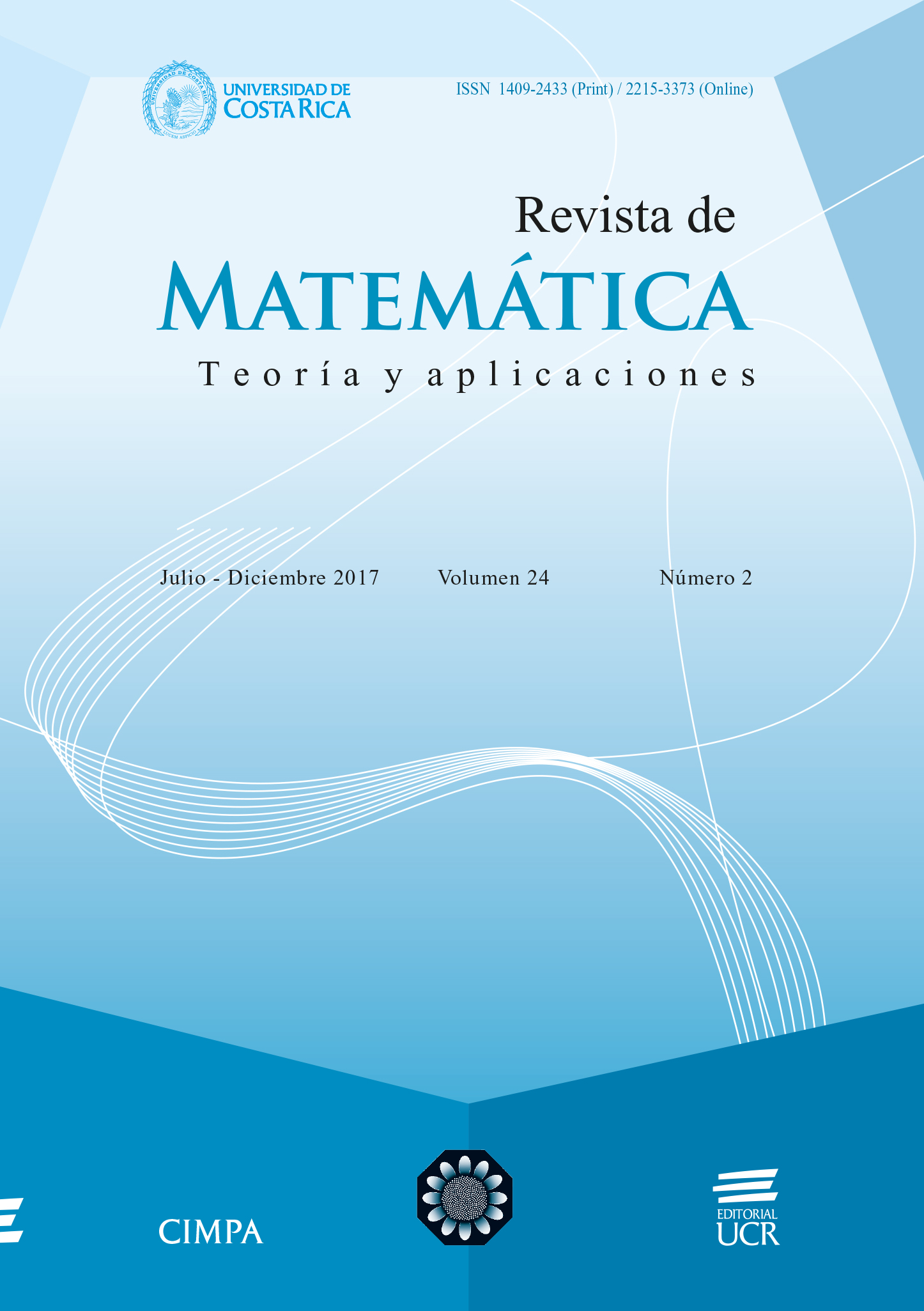Abstract
Fuzzy mathematics generalize concepts of traditional mathematics using fuzzy sets. This enables to study and model more properly phenomens characterized by imprecision. These generalizations includes concepts of algebra, analysis and topology. On the other side, cubical complexes have applications in digital image processing and in the study of dynamical systems, but in the actual literature there is not an extension of their properties using fuzzy sets. In this paper is proposed a generalization of the concept of cubical complex and of some of their properties, such as connectedness, polyhedral realization, connected component and holes, using fuzzy sets. The upper and lower trees of a fuzzy cubical complex are defined, which give information about the way in which its regional extrema are related. The homology groups of a fuzzy cubical complex are defined and it is shown that the rank of the 0-homology group of a given level is equal with the number of regional maxima of that level. Finally, it is shown how to associate a fuzzy cubical complex with a bidimensional digital grayscale image in order to study somo of its topological properties.
References
Allili, M.; Mischaikow, K.; Tannenbaum, A. (2001) “Cubical homology and the topological classification of 2D and 3D imagery”, en: Proceedings of the International Conference on Image Processing 2001, Vol. 2, IEEE, Grecia: 173–176.
Bairamov, S.; Gunduz, C. (2010) “The Čech homology theory in the category of Šostak fuzzy topological spaces”, International Journal of Contemporary Mathematical Sciences 5(9): 433–448.
Bykov, A.I.; Zerkalov, L.G. (1996) “Algorithms for homotopy classification of binary images”, Pattern Recognition 29(4): 565–574.
Bykov, A.I.; Zerkalov, L.G.; Albores Velasco, F.J.; Rodríguez Pineda, M. A. (1998) “New connected components algorithm and invariant transformations of digital images”, Pattern Recognition 31(8): 1089–1098.
Bykov, A.I.; Zerkalov, L.G.; Rodríguez Pineda, M.A. (1999) “Index of a point of 3-D digital binary image and algorithm for computing its Euler characteristic”, Pattern Recognition 32(5): 845–850.
Chang, C.L. (1968) “Fuzzy topological spaces”, Journal of Mathematical Analysis and Applications 24(1): 182–190.
Couprie, M.; Nivando Bezerra, F.; Bertrand, G. (1999) “Grayscale image processing using topological operators”, Proceedings SPIE Vision Geometry VIII 3811: 261–272.
Cuvalcioglu, G.; Citil, M. (2006) “On fuzzy homotopy theory”, Advanced Studies in Contemporary Mathematics 12(1): 163–166.
Kaczynski, T.; Mischaikow, K.; Mrozek, M. (2003) “Computing homology”, Homology, Homotopy and Applications 5(2): 233–256.
Kerre, E.E. (2005) “A historical overview of fuzzy mathematics”, New Mathematics and Natural Computation 1(1): 1–26.
Kong, T.Y.; Rosenfeld, A. (1989) “Digital topology: introduction and survey”, Computer Vision, Graphics and Image Processing 48: 357–393.
Li, S.G. (2000) “Connectedness in L-fuzzy topological spaces”, Fuzzy Sets and Systems 116(3): 361–368.
Lowen, R. (1978) “A comparison of different compactness notions in fuzzy topological spaces”, Journal of Mathematical Analysis and Applications 64: 446–454.
Lowen, R. (1980) “Convex fuzzy sets”, Fuzzy Sets and Systems 3(3): 291–310.
Lowen, R. (1981) “Connectedness in fuzzy topological spaces”, Rocky Mountain Journal of Mathematics 11(3): 427–433.
Lubczonok, P. (1990) “Fuzzy vector spaces”, Fuzzy Sets and Systems 38(3): 329–343.
Monasse, P.; Guichard, F. (2000) “Fast computation of a contrast-invariant image representation”, IEEE Transactions on Image Processing 9(5): 860–872.
Mrozek, M.; Batko, B. (2009) “Coreduction homology algorithm”, Discrete Computational Geometry 41: 96–118.
Najman, L.; Couprie, M. (2006) “Building the component tree in quasi- linear time”, IEEE Transactions on Image Processing 15(11): 3531–3539.
Niethammer, M.; Kalies, W.D.; Mischaikow, K.; Tannenbaum, A. (2006) “On the detection of simple points in higher dimensions using cubical homology”, IEEE Transactions on Image Processing 15(8): 2462–2469.
Rodríguez-Pineda, M.A. (1997) El Concepto de Índice de un Punto Lattice en el Análisis Homotópico de 2D y 3D Imágenes y su Realización Algorítmica. Tesis de doctorado, Benemérita Universidad Autónoma de Puebla, México.
Rosenfeld, A. (1971) “Fuzzy groups”, Journal of Mathematical Analysis and Applications 35(3): 512–517.
Rosenfeld, A. (1979) “Digital topology”, The American Mathematical Monthly 86(8): 621–630.
Rosenfeld, A. (1979) “Fuzzy digital topology”, Information and Control 40(1): 76–87.
Rosenfeld, A. (1983) “On connectivity properties of grayscale pictures”, Pattern Recognition 6(1): 47–50.
Salleh, A.R. (1993) “The homotopy property of the induced homomorphisms on homology groups of fuzzy topological spaces”, Fuzzy Sets and Systems 56(1): 111–116.
Sidky, F.I.; Mishref, M.A. (1991) “Fuzzy cosets and cyclic and abelian fuzzy subgroups”, Fuzzy Sets and Systems 43(2): 243–250.
Wang-Jin, L.; Chong-You, Z. (1985) “Singular homology groups of fuzzy topological spaces”, Fuzzy Sets and Systems 15(2): 199–207.
Ying-Ming, L.; Mao-Kang, L. (1996) Fuzzy Topology. World Scientific, Singapore.
Zadeh, L.A. (1965) “Fuzzy sets”, Information and Control 8(3): 238–253.
Zadeh, L.A.; Fu, K. S.; Tanaka, K.; Shimura, M. (1975) Fuzzy Sets and Their Applications to Cognitive and Decision Processes. Academic Press, New York.
Ziou, D.; Allili, M. (2002) “Generating cubical complexes from image data and computation of the Euler number”, Pattern Recognition 35(12): 2833–2839.
Comments

This work is licensed under a Creative Commons Attribution-NonCommercial-ShareAlike 4.0 International License.
Copyright (c) 2017 Revista de Matemática: Teoría y Aplicaciones





